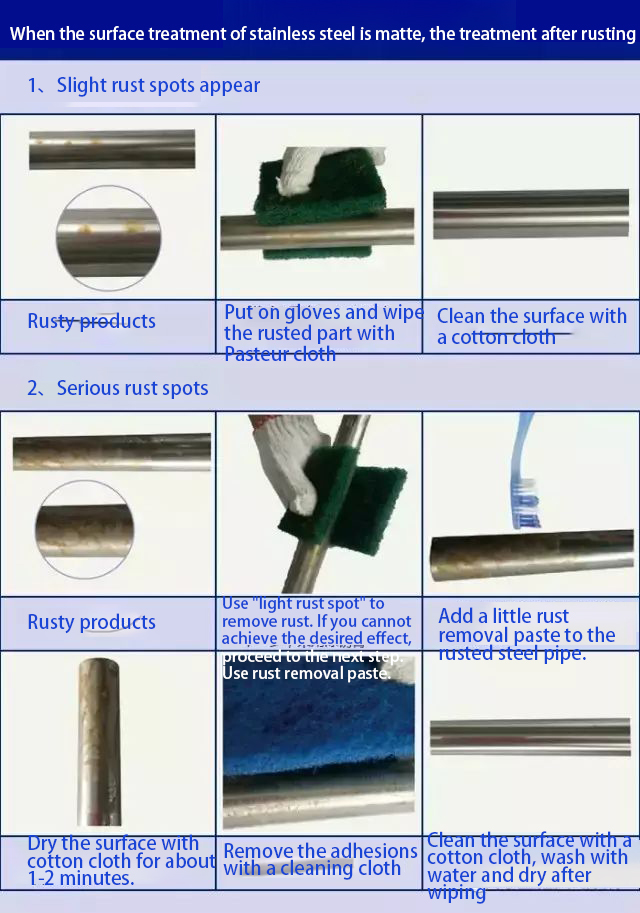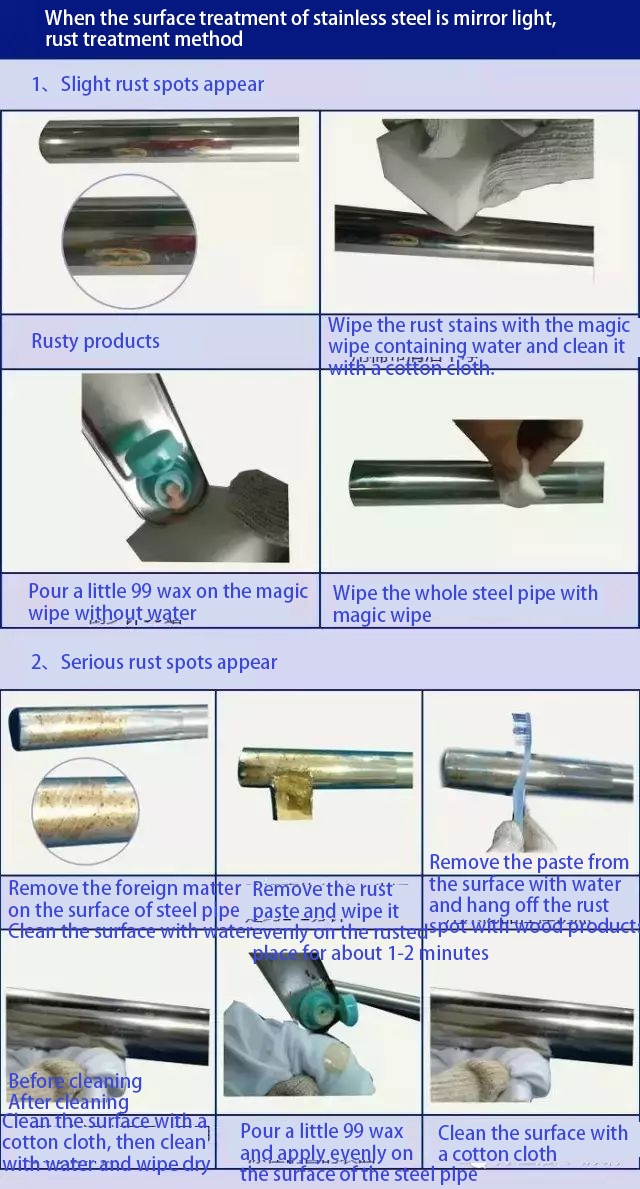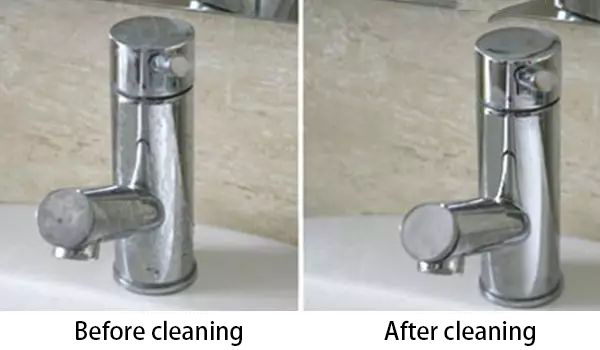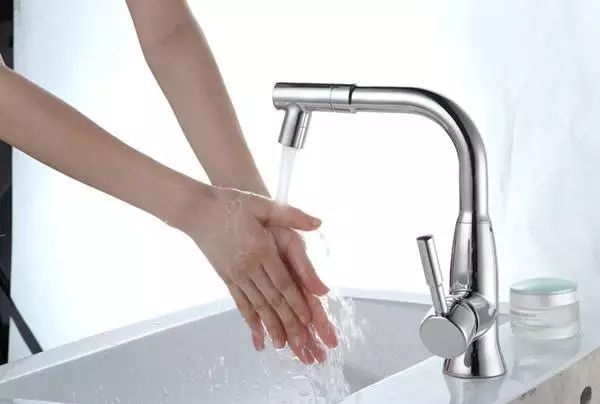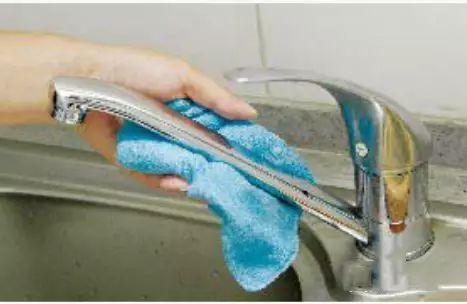Bathroom Business School
1 Why does stainless steel also rust?
Why does stainless steel also rust?
When the surface of the stainless steel pipe appears brown rust spots (points), people are surprised: think “stainless steel is not rust. Rust is not stainless steel, it may be a problem with the quality of steel”. In fact, this is a one-sided misconception of the lack of understanding of stainless steel. Stainless steel will also rust under certain conditions.
Stainless steel has the ability to resist atmospheric oxidation – that is, stainless steel. It also has the ability to be corroded in the medium containing acid, alkali, salt — that is, corrosion resistance. But the size of its corrosion resistance is with its steel itself chemical composition, plus mutual state, the use of conditions and environmental media type and change. Such as 304 steel pipe, in a dry and clean atmosphere, there is absolutely excellent corrosion resistance. If it is moved to the seaside area, in the sea spray containing a large amount of salt, it will soon rust. 316 steel pipe, on the other hand, performs well. Therefore, not any kind of stainless steel, in any environment can be corrosion-resistant, rust-free.
Stainless steel is formed on its surface by a layer of very thin and strong and dense stable chromium-rich oxide film (protective film), to prevent the continued penetration of oxygen atoms, continued oxidation, and the ability to resist rust and corrosion. Once there is some reason, this film is continuously destroyed. Oxygen atoms in the air or liquid will continue to penetrate or iron atoms in the metal will continue to precipitate out, forming loose iron oxide, and the metal surface will be subject to continuous rusting. This surface film is damaged in many forms, the following are common in daily life.
- Stainless steel surface contains the accumulation of other metal elements of dust or adhesion of foreign metal particles. In the humid air, the adhesions and stainless steel condensation between the two will be connected into a microcell, triggering an electrochemical reaction. The protective film is damaged, called electrochemical corrosion.
- Stainless steel surface is adhered to the organic juice (such as squash, noodle soup, spit, etc.). In the presence of water and oxygen, constitutes an organic acid. Long-term opportunity to cause corrosion of the metal surface.
- Stainless steel surface is adhered to substances containing acids, alkalis and salts (such as decorative walls of alkaline water, lime water spray), causing local corrosion.
- In polluted air (such as containing a large number of sulfides, carbon dioxide, nitrogen oxide atmosphere), when it meets condensate, sulfuric acid, nitric acid, acetic acid liquid point will be formed, causing chemical corrosion.
All of the above can cause the destruction of stainless steel surface protective film triggered by rust corrosion. Therefore, to ensure that the metal surface is permanently bright and not rusted, we recommend that
- The decorative stainless steel surface must be cleaned and scrubbed frequently to remove the adhesions and eliminate the external factors that trigger the finishing.
- The seaside area should use 316 stainless steel. 316 material can resist seawater corrosion.
- Some stainless steel pipe on the market chemical composition can not meet the corresponding national standards, not up to 304 material requirements. Therefore, it will also cause rust, which requires users to carefully select a reputable manufacturer’s products.
Why is stainless steel also magnetic?
People often think that the magnet adsorbs stainless steel material to verify its merits and authenticity. If it does not adsorb, it represents no magnetism and is considered good and genuine. If it can be adsorbed, it means magnetic and is considered counterfeit. In fact, this is an extremely one-sided, not practical and wrong identification method.
There are many types of stainless steel. At room temperature, according to the organizational structure can be divided into several categories:
1, Austenitic type: such as 201, 202, 301, 304, 316, etc.
2, Martensitic or ferritic type: such as 430, 420, 410, etc.
Austenitic type is non-magnetic or weakly magnetic, martensitic or ferritic is magnetic.
Most of the stainless steel usually used as decorative pipe plate is austenitic type 304. Generally speaking it is non-magnetic or weakly magnetic, but the magnetic properties may also appear due to fluctuations in chemical composition caused by smelting or different processing states. But this can not be considered as impostor or substandard, what is the reason for this?
Above mentioned austenite is non-magnetic or weakly magnetic, while martensite or ferrite is magnetic. Due to smelting composition bias or improper heat treatment, it will cause a small amount of martensite or ferrite organization in austenitic 304 stainless steel. In this way, 304 stainless steel is slightly magnetic. In addition, after the cold working of 304 stainless steel, the organizational structure will also be transformed to martensite. The greater the degree of cold working deformation, the more martensite transformation, and thus the greater the magnetic properties of the steel. For example, the same batch number of steel strip is produced Φ76 pipe. If there is no obvious magnetic feeling, produce Φ9.5 pipe. Because of the larger deformation of cold bending, the magnetic sense is obvious some. Production of square rectangular tube because of the deformation is larger than round tube. Especially the folding part, the deformation is more intense and the magnetism is more obvious.
To completely eliminate the above reasons for the magnetic properties of 304 steel, high-temperature solution treatment can be opened to restore stable austenite organization, thereby eliminating the magnetic properties.
Due to the above reasons caused by the magnetic properties of 304 stainless steel, and other materials of stainless steel, such as 430, carbon steel magnetism is not at all the same level. That is to say, the magnetic properties of 304 steel always show a weak magnetic properties. This tells us that if the stainless steel with weak magnetism or completely without magnetism, should be judged as 304 or 316 material. If the same magnetic properties as carbon steel, showing strong magnetism, should be judged as not 304 material.
We recommend that the purchase of stainless steel products should be selected from reputable manufacturers, do not be greedy for cheap, beware of being fooled.
2, Tips for dealing with stainless steel rust
How to prevent stainless steel faucets and sinks from rusting?
To ensure that the metal surface is permanently bright and not rusted, we recommend that
Frequent cleaning and scrubbing of the decorative stainless steel surface to remove adhesions and eliminate external factors that trigger rusting. The method of treatment is as follows:
Tips for rusting stainless steel sink
1、Toothpaste
The best way to remove rust is this necessity in life – toothpaste. First wet the rusty place with water, then squeeze out the toothpaste with a soft cloth and gently scrub, and then rinse with water quiet. This can be repeated several times until the rust is removed.
2、White vinegar
Let white vinegar covers the rust area evenly, you can use it together with salt. Because white vinegar contains acetic acid, rust and acetic acid will react.
3、Potato peel
Use the peeled potato skin (the flesh side), repeatedly wipe the surface of the stainless steel faucet. You will find that dirt and scale will slowly be cleaned off.
3, The maintenance of stainless steel faucets and maintenance
1, When the room temperature is lower than zero degrees Celsius, the faucet is prone to abnormalities such as faucet handle feel will appear abnormal. This time to use hot water to shower to the faucet until it returns to normal and then use.This time to use hot water to shower to the faucet until it returns to normal and then use. This will not affect the life of the faucet.
2, The home faucet will often appear to have dirt phenomenon. In the process of use to regularly clean up the surface, you can use a clean soft cloth with neutral soapy water to wipe clean. Do not use corrosive chemicals and hard brushes to clean up, such as ammonia, decontamination powder, toilet cleaner, iron brush, etc., so as not to cause surface damage.
3, To ensure the durability of the product. Faucet in the process of use can not be too hard. Even if it is a traditional faucet, you can not vigorously to screw. You have to turn gently with the momentum. Close the faucet when you do the same. Then again, do not use the faucet as a handrail to support heavy objects.
4, When there is bleach as well as various acids attached, immediately rinse with water, and then use ammonia solution or neutral carbon soda solution. Wash with neutral detergent or warm water.
5, When not using the faucet for a longer period of time, it is recommended to close the main valve of the incoming water at home.
 VIGA Faucet Manufacturer
VIGA Faucet Manufacturer 
